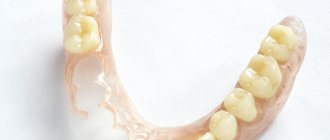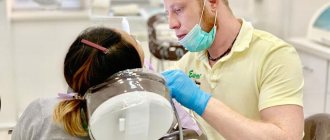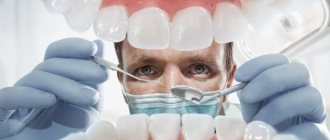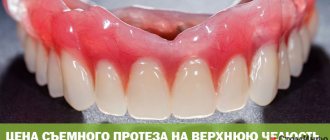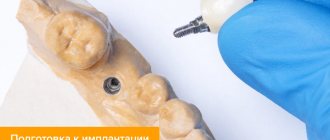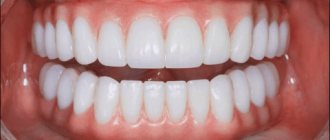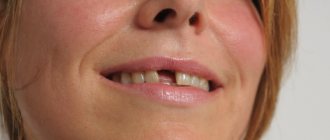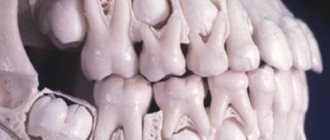- How the installation process works
- How long does it take to get used to it and how to wear the record?
- Why is it better to contact the Esculapius clinic?
Sometimes it happens that a baby loses baby teeth long before they should fall out naturally.
This situation can lead to unpleasant consequences, such as malocclusion, increased load on the dentition, impaired speech functions, and abnormal development of bone tissue. It is possible to prevent such a development of events by using a replacement plate after the removal of a baby tooth. This plate, instead of an extracted baby tooth, allows you to normalize the functions of swallowing, chewing, speech, and also protect existing teeth from damage.
What are the risks of early loss?
For normal physiological change of teeth in children, several conditions are necessary. First of all, these are fully formed and formed rudiments of molars, and for this - the resorption of the deciduous roots.
But it is not always possible to keep baby teeth healthy until they are replaced.
The main causes of their damage:
- poor nutrition;
- insufficient hygiene;
- illnesses and taking certain medications;
- general environmental factors;
- injuries: bruises, blows, etc.
If a baby tooth is lost or had to be removed, then in this case a molar will still grow in its place, but strictly at the time when it is provided for by nature.
Here are the approximate growth times :
- central and lateral incisors – at 6-9 years;
- first premolars – 9-10 years;
- fangs – 10-11 years;
- second premolars – 10-12 years.
When baby teeth are lost too early for one reason or another, in most cases this leads to the most unpleasant consequences:
- Increasing loads from chewing on the remaining teeth.
- Lack of normal growth and development of bone tissue at the site of the lost tooth, which prevents proper eruption.
- Chaotic growth of permanent teeth is possible - out of row or arch, crowding, etc.
The milk teeth standing next to the empty space try to occupy it, gradually moving, so when the molar erupts there will not be enough space for it. - Reduced bite height.
- Anomalies in the development of the dental system , in particular, malocclusion pathologies.
- Poor chewing of food , which disrupts the functioning of the digestive system.
- Impaired speech functions , poor diction.
- Temporomandibular joint diseases.
- Psychological problems.
Don't know which fixed dentures are best? Read our recommendations in the new review.
In this article we will tell you why baby teeth fall out.
Here https://www.vash-dentist.ru/protezirovanie/tsenyi-p/skolko-budet-stoit-vstavit-zub.html we will calculate how much it costs to insert a ceramic tooth and tell you what it depends on.
Functions of orthopedic structures
The main purpose of dentures for children is to prevent the possible consequences of early tooth loss:
- Normalization of important physiological functions: swallowing, chewing, speech.
- Prevention of breathing problems and diseases of the ENT organs.
- Prevention of functional and morphological disorders in the development of the dental system and facial structure.
When can it be used
Children's crowns can be placed starting from the age of 2. Sometimes there are situations in which a specialist installs the structure earlier, for example, with congenital hypoplasia of the enamel layer. Each clinical case requires an individual approach, and determining the indications is within the competence of the doctor.
DENTAL PROSTHESIS ON 6 IMPLANTS - 290,000 rub.
The price includes all manipulations for installing Osstem implants (South Korea), manufacturing, installing and fitting the prosthesis, including anesthesia and diagnostics.
Save RUB 30,000. >> Call now or request a call
Opening hours: 24 hours a day - seven days a week
Indications and contraindications
To begin with, it should be said that there are no absolute contraindications to dentures for baby teeth, except those that are common to everyone. These include some diseases, in particular mental ones.
Usually they only talk about local and temporary contraindications that can be eliminated:
- acute stages of viral and inflammatory non-systemic diseases;
- recent radiation therapy;
- acute stress;
- lack of hygiene;
- conflict between child and parents.
Even if you are individually intolerant to the material from which the prostheses are made, you can choose an adequate replacement that does not cause allergic reactions.
Indications:
- Destruction of the coronal (upper) part by caries, when it cannot be restored.
- Trauma: chipping of the crown, fracture of the base or root, etc.
- Fluorosis, which provoked tooth decay.
- Inflammation that begins in the bone tissue, which requires tooth extraction.
- Periodontitis causing loosening.
- Enamel hypoplasia (systemic).
- Bruxism is teeth grinding caused by excessive tension in the chewing muscles.
Why put crowns on children's baby teeth? Author Irina Rotmanova
- ru en
- uk
- home
- Articles by doctors
- Why put crowns on children's baby teeth? Author Irina Rotmanova
Why put crowns on children's baby teeth? Author Irina Rotmanova
Milk teeth must fulfill their role in the oral cavity before they are replaced by permanent ones, but, unfortunately, there are situations when they are destroyed ahead of time. And if the damage is minor, then modern filling materials can quite effectively fill such a defect. But in the case of significant damage, when there is significantly less healthy tissue left than the damaged one, or the conditions for restoration with a filling are questionable, it is necessary to look for alternative ways to restore the hard tissues of baby teeth. In such situations, a crown on a baby tooth comes to our aid. They are very similar to prostheses for adults, but have their own characteristics, which we will talk about later.
Why put crowns on children's baby teeth? Author Irina Rotmanova
How are they divided according to purpose?
Depending on the functions performed, that is, their intended purpose, dentures for baby teeth can be removable or non-removable .
Removable
Their defining feature is the ability, if necessary, to easily and quickly remove the structure. They can be made from the same material, or combine different properties.
- Bridges .
They are used to replace a significant extent of row defects (from three or more missing teeth). Most often they are made from various types of plastics. It is also possible to use metal for the manufacture of fasteners or individual structural parts. - Plate dentures .
According to reviews, the most common variety. They have a common part - a plastic base with fasteners. They can be either stationary or sliding. Similar designs are also used in orthodontics to correct malocclusions and the position of certain teeth. - Immediate prosthesis .
Small one-piece structures made of thermoplastic masses based on nylon, also called “butterflies” because of their shape. They are a crown with elastic clasps that cover adjacent teeth, holding the device. Most often they are used when one baby tooth is lost as a result of injury.
Fixed
Typically, non-removable structures are those that are designed to restore partial defects - without complete loss of the tooth. In most cases, they are chosen if there is a preserved, albeit severely damaged, crown and intact roots.
- Tabs .
Required when the crown is destroyed without affecting the pulp, for example, by caries, or when there is increased abrasion. In essence, the inlay is a large filling that replaces the lost part, maintaining the anatomical shape of the surfaces. - Pin tabs .
Necessary in case of damage to the pulp and the need to remove it, as well as in cases of preserved roots and an almost lost crown. The pin is installed as carefully as possible, without damaging the thin walls of the roots. For them, chromium-nickel and gold alloys are used, and then the crown is restored using plastic or porcelain facets. - Crowns .
These are metal structures that completely restore the coronal part, replacing it. Most often, medical-grade stainless steel or safe chromium-nickel alloy are used. - Strip crowns .
A new method that involves partial restoration of the front teeth using special removable caps made of acrylic or light-curing composite. The crown of the tooth is prepared (ground down) and a cap filled with luting cement is placed on it. They are used for active caries, enamel hypoplasia, mechanical damage, and amelogenesis disorders.
Popular brands of children's crowns
The range of children's crowns cannot be called wide. At the moment, the most widely used products are from two manufacturers:
- NuSmile – are highly aesthetic, durable, and hypoallergenic. Products of this brand are popular not only in pediatric dentistry, but also in adult dentistry. The structures are made of metal and covered with ceramics,
- 3M ESPE DENTAL - the company presents both crowns and caps (strip dentures). For production, the manufacturer uses special alloys that are biologically compatible with living tissue. In pediatric dentistry, nickel-chrome products are installed on the chewing group, and zirconium ceramics are installed on the anterior units of the dentition.
“When the child damaged his front teeth, I didn’t know whether it was possible to get crowns or whether they would have to be removed. It’s good that the doctor himself suggested it. White, smooth, like your own. Now the child is happy, and I am calm.”
Valentina R., from a review from babyblog.ru
What requirements must be met?
Compared to dental restoration structures used for adults, children's dentures must meet fairly stringent requirements regarding literally all aspects of this issue.
This is due to the need to take into account the fact that the baby’s body is not yet fully formed, it is growing and developing.
This is not only about the fact that the embryonic molars need to be provided with conditions for growth, taking into account the increasing size of the jaws. Children are also more susceptible to exposure to various types of materials.
The body cannot yet fully prevent the influence of various substances, the harmful development of microorganisms, and so on. All this requires the use of only suitable materials in simple designs that will not harm the health of children.
Another important circumstance that must be taken into account is that denture designs should not require any damage, for example, grinding of adjacent teeth .
Safety of use
The design requirements are also special. First of all, they concern the safety of the child.
With the help of a prosthesis, it is impossible to get hurt, injure the mucous membranes and soft tissues; the child should easily learn how to operate the device and fully understand the rules established for hygienic procedures.
So, designs must meet the following requirements :
- maximum simplicity;
- atraumatic;
- aesthetics;
- should not in any way interfere with the growth and development of the dental arches and jaws in general.
We will discuss what factors influence the price of a metal-ceramic tooth crown here.
In the next publication we will tell you in what cases the method of silvering baby teeth is used.
At the link https://www.vash-dentist.ru/protezirovanie/semnyie-p/pokryivnyie/zubnyie-vidyi-osobennosti-i-tsenyi.html you will find reviews about the effectiveness of overdentures.
What materials are they made from?
Dentures intended to be worn by children are subject to increased requirements, which relate primarily to materials of manufacture. The child’s body is highly susceptible and prone to allergic reactions.
That is why all materials used in the production of orthopedic structures must meet certain conditions and be:
- hypoallergenic;
- non-shrinking;
- lungs;
- durable;
- hygienic;
- not absorbing moisture;
- resistant to various types of influences.
Most often in the manufacture of these structures, acrylate, nylon, chrome, as well as stainless steel of the EI-95 grade and alloys based on gold, silver and tin are used.
Stages of the procedure
Prosthetics of baby teeth is a very important procedure on which the future health of the child depends.
That is why, regardless of the type of design used in each individual case, it should be carried out by a professional doctor at a specialized children's clinic, who will take into account all possible factors of its influence.
Here are the general stages of prosthetics , which are mandatory:
- examination and consultation;
- diagnostic stage: detailed interview and examination of the patient (x-ray);
- preparation for prosthetics (if necessary, preliminary treatment: endocanal, grinding of hard tooth tissues, etc.);
- taking impressions;
- production of prosthesis;
- fitting and installation of the structure.
It should be clarified that the installation of any type of prosthesis also requires general preparation of the teeth - professional cleaning of the enamel surface from any contaminants: soft and hard plaque, tartar.
How prosthetics are performed, watch the video:
Crown care
Diet and regular, proper oral hygiene are very important here. It is necessary to avoid hard foods that can lead to chipping of the crown - it is important to exclude crackers, dryers, and candies. If possible, it is also necessary to protect children from injuries and from bad habits of gnawing on everything. Yes, it will be difficult, but this is exactly what will allow you to keep your teeth with crowns safe and sound.
Author: Matyushenko M. A. (Thank you for your help in writing the article and the information provided)
Duration of use
The duration of use of prostheses and their service life are different concepts. Moreover, both depend on the type of structure.
Fixed structures, such as pin inlays, are usually not replaced. They replace part of the crown until the tooth is replaced with a molar.
The situation is different with removable devices. Their service life is much longer than the time that the child will need to wear them.
The average period for which dentures are installed is about 6-8 months. However, it all depends on the specific clinical picture - sometimes they are worn for 3-4 months, and sometimes for more than a year.
What is the price?
It is impossible to give a general price for all prostheses used in pediatric dentistry. It directly depends on the type of structure, its size, materials used for manufacturing, and the number of teeth being replaced.
also worth considering the cost of preliminary and preparatory procedures that may be needed: professional cleaning, taking impressions, treatment of caries, canals, etc.
The minimum cost of replacing one lost baby tooth is about 1000 rubles .
In a design that implies the presence of clasp fixation, an increase in the number of fasteners increases the cost by an average of 800-1000 rubles. The use of precious metals in manufacturing also increases the price.
Sometimes the total cost of the entire treatment and installation of a prosthesis can reach up to 5-10 thousand rubles .
If you find an error, please select a piece of text and press Ctrl+Enter.
Tags loss of baby teeth dentures baby teeth fixed dentures fixed dentures prosthetics removable dentures for children
Did you like the article? stay tuned
Previous article
In what cases does a tooth react to cold and hot?
Next article
What are the consequences of an incorrect bite?
